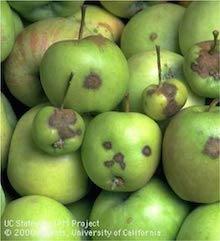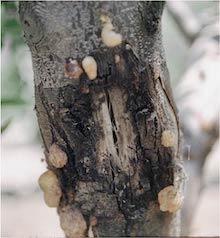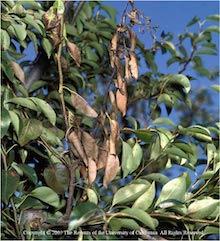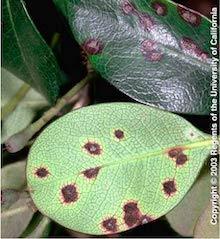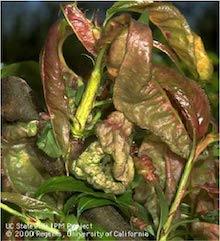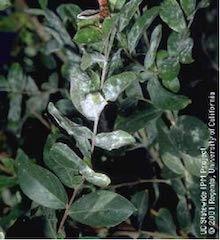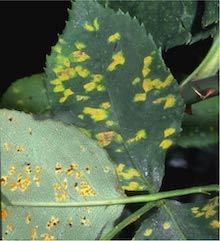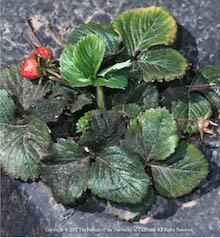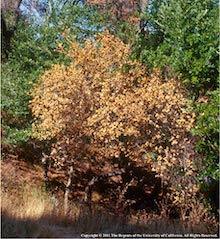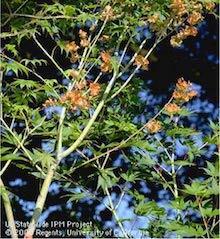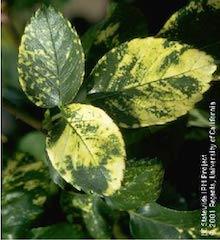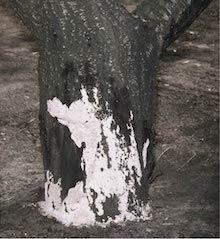| Apple and pear scab are two different diseases with similar symptoms. Scab first appears as yellow or chlorotic spots on leaves. As the disease progresses, dark, olive-colored spots form on leaves, fruit, and sometimes, on stems. Scab can destroy an apple or pear crop. Removing, then composting or destroying dropped leaves in autumn or winter can restrict the disease to tolerable levels. Resistant cultivars are available. Read more about scab diseases here. |
Canker diseases are caused by the invasion of a fungal pathogen into woody tissues. A canker is a localized dead (necrotic) area varying in appearance but often discolored, oozing, or sunken. Mechanical injuries (e.g., equipment impact and pruning), sunburn, sunscald, and bacterial blights can induce the fungal pathogen. Canker diseases tend to affect plants that lack proper cultural care or that are poorly adapted to local conditions. Read more about canker diseases here. |
Fire blight is a common and frequently destructive disease of pear, quince, apple, crabapple, firethorn and many other related plants. The disease can destroy limbs or the entire tree. The initial signs of fire blight are cankers that form early in spring, but infections might not be noticed until later when flowers, shoots, and/or young fruit shrivel and blacken. Trees prone to fire blight should be regularly monitored for symptoms and diseased wood should be removed immediately. Read more about fire blight here. |
| Leaf spot diseases are caused by various fungal pathogens and many trees and shrubs are susceptible. Spots may vary from small discrete dots and raised areas to irregular yellow or brownish patches that cover much of the leaf surface. Leaves may fall off the tree if the problem is severe. Leaf spot diseases can be controlled by raking up and removing affected leaves, avoiding overhead watering, and assuring adequate air circulation in plantings. Read more about leaf spot diseases here, here, and here. |
Peach leaf curl is a fungal disease that affects only peach and nectarine trees. Distorted, reddened foliage in spring is a distinctive symptom and cool, wet springs encourage peach leaf curl. If left untreated, peach leaf curl can weaken a tree over time. To prevent this disease, use resistant peach and nectarine varieties. Non-resistant trees can be treated with an organic fungicide during the dormant season. Read more about peach leaf curl here. |
Powdery mildew is a common fungal disease that thrives in warm, dry conditions. A white powdery growth on leaves and shoots is a sure sign of this disease. Eventually the leaves will turn yellow or brown and drop. Many different types of plants are susceptible to powdery mildew, including ornamentals, fruits, and vegetables. Powdery mildew can be controlled by ensuring plants receive ample sunlight and adequate air circulation. Overfertilizing can encourage the growth of powdery mildew. Read more about powdery mildew here. |
| Rusts are fungal diseases identified by orange, red, or yellow growths, gelatinous to dry in texture, that form on many kinds of woody plants and flowering ornamentals. Infected conifers may develop bushy growth, oozing cankers and spotted needles while broadleaf trees and flowering plants may drop infected foliage prematurely. Rusts can often kill their hosts. Rusts can be controlled by removing infected leaves and shoots as soon as they appear and by avoiding overhead watering. Read more about rust diseases here. |
Sooty mold is a fungal disease resembling a layer of soot that grows on leaves and other plant surfaces covered by honeydew, a sticky substance excreted by insects that consume plant sap. The presence of sooty mold indicates that aphids, leafhoppers, scales, mealy bugs and other insects that suck sap from plant tissues are or were present. Sooty mold can be controlled by addressing the conditions that encourage sap sucking insects. Read more about sooty mold here. |
Sudden Oak Death is a disease caused by the invasive plant pathogen, Phytophthora ramorum. Infections caused by this pathogen cannot be identified on field symptoms alone and must be confirmed through lab testing. Once an infection occurs, there is no known way to cure the disease. Therefore, most management practices are directed at preventing the spread of the disease to new plants or areas and protecting susceptible trees before they are infected. Read more about Sudden Oak Death disease here.
|
| Vascular wilts caused by the fungi Fusarium and Verticillium damage a plant’s water and nutrient conducting tissues. In infected plants, foliage will yellow, wilt, turn brown and die. Both pathogens infect a variety of trees, shrubs, flowering plants, and vegetables. Keeping plants vigorous and healthy through good cultural practices is the best preventative strategy. In situations where wilts cannot be controlled, planting resistant varieties is the best alternative. Read more about vascular wilts here and here. |
Viruses are submicroscopic pathogens that infect plant cells, changing the appearance of foliage, flowers, and fruits. Virus-infected leaves can become spotted, streaked, mottled, distorted, or stunted. Viruses can slow plant growth, but usually do not seriously harm woody plants. Herbaceous ornamentals and certain vegetables are more susceptible to serious disease or death. The spread of viruses can be curtailed or prevented with good sanitation and cultural practices. Read more about plant viruses here and here. |
Wood decay fungi cause a variety of diseases in plants, including heart rots, sap rots and canker rots. Under favorable conditions, extensive portions of the wood of living trees can decay in a relatively short time (i.e., months to years). Wood decay is usually a disease of old trees. Trees can be protected from wood decay fungi by preventing bark injuries and providing proper cultural care to maintain tree vigor. Young trees should be pruned properly to promote sound structure. Read more about wood decay fungi here. |

